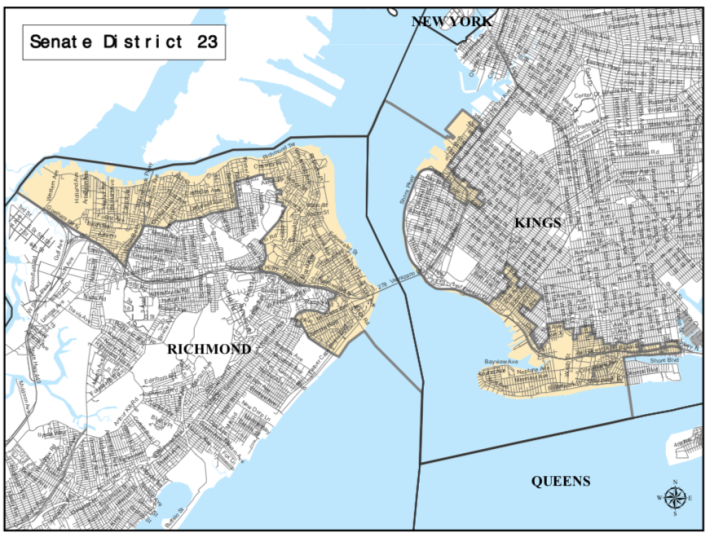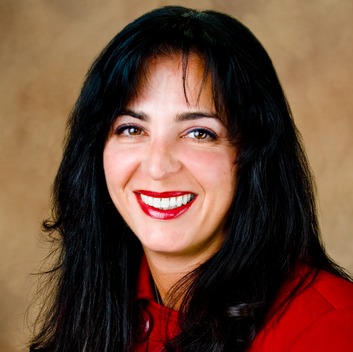Insurgent candidates are challenging incumbents in Albany this year like never before — and for good reason: The State Senate's failure to pass speed camera legislation this summer, the legislature's stall on congestion pricing, and the upper chamber's general political dysfunction are motivating people to focus on whether Albany itself is working.
So Streetsblog asked candidates in the upcoming Democratic primaries to answer basic questions about street safety and mobility. Today we look at the 23rd Senate District, which covers parts of Staten Island and southern Brooklyn, pitting challenger Jasmine Robinson vs. incumbent Diane Savino. StreetsPAC did not make an endorsement, despite the fact that Savino was a member of the Independent Democratic Conference, which caucused with Senate Republicans to give the GOP control of the chamber — which it wielded to block the expansion of the speed camera program.
Here are the candidates' answers, unedited, with a map of the district at the bottom of this post:
Do you support congestion pricing in New York City? If so, in what form? If not, why not?
ROBINSON: I support to some degree. The proposed investments to mass transit must be immediate.
It has to include upgrades to the signaling network and making all subway stations accessible for all.
We should not have to wait until after we start charging congesting pricing fees to make investments in our system.
The MTA should issue bonds to be paid from future revenues and begin investing in our system now.
SAVINO: The MTA is currently in desperate needs of funds to move forward with its necessary repairs. New York needs a congestion pricing plan that is equitable and fair to all commuters. That is why I am a cospsonsor to S6287, which would enact the MoveNY plan into law. This plan should be the starting point for any discussion about the future of transportation policy in New York. It provides a funding roadmap that equally distributes the financial burden throughout the region and ensures that everyone is treated fairly.
Subway ridership is down and New York's buses are slower than ever. What will you do in Albany/are doing in Albany to fix it?
ROBINSON: I support to make sure our buses are on time! There was a push to eliminate some stops on the expressbus routes. Many buses are crowded and packed. We need to figure out another solution that will benefit all. Also some of the MTA buses are not handicap accessible. We need to do more to accomodate riders with special needs. They should not be stranded or left behind.
SAVINO: Staten Island has been neglected when it comes to transportation options, for far too long. The MTA, year after year, makes cuts to bus service on Staten Island when Staten Islanders are the ones that have some of the longest commutes in the country. With pressure from other Staten Island officials and I, the MTA has changed course this year by bringing a Bus Rapid Transit system to the North Shore. This does not, however, address the lack of express bus lines running into Manhattan. 56,000 people make the commute from Staten Island to Manhattan for work every day. Express bus service is what most of these commuters rely on, and it is my priority to fight for more bus lines to be established connecting the two boroughs.
This lack of buses could be supplemented by the ever-growing ferry service in the region. Fast Ferry service has proven to be an effective new way for New Yorkers to get around. It has made the commutes for many people much faster. I am advocating for it expansion to Staten Island’s North Shore and Coney Island. Both locations are perfect locations for a ferry stop.
MTA capital projects routinely cost five times as much as transit projects in other cities. How will you exert pressure on the MTA to control costs?
ROBINSON: There needs to be an independent audit of MTA. I strongly believe that the MTA needs to do a better job with the funds. I believe this independent audit will give the public insight into the ways the MTA waste money. It is very imperative to overhaul the procurement process entirely and have competitive bidding on projects. Time after time politically connected contractors are chosen for these projects as opposed to a more deserving contractor. This is why our subway system is a failure at times.
SAVINO: I have pushed year after year to have an independent forensic audit of the MTA conducted, which is why I voted for S6303 in the past legislative session. The taxpayers deserve to know how their money is being spent. It would also be beneficial for the MTA to see where they can better invest their funds. If we know where they are wasting funds, we can hold them accountable for it.
How would you make streets in your district safer for walking and biking? Do you support the city's construction of protected bike lanes? If so, why? If not, why not?
ROBINSON: I am in favor of expanding our protected bike lanes, speed bumps, speed cameras in every school zone which should be permanent and not up for renewal. We need to increase street redesigns that put the safety of pedestrians and cyclists first. We need to protect everyone’s safety and well being on the road.
SAVINO: Bikers deserve a designated lane to use for recreational or transportation purposes. Bike lanes give bikers an area on a road to travel, without worrying about pedestrian or vehicular traffic. They make everyone involved safer. The creation of more bike lanes takes us that much closer to achieving the goals of Vision Zero.
What is the single biggest thing the state should do to get reckless drivers off New York City streets?
ROBINSON: Suspend licenses for drivers with multiple violations. We also need to go after drivers with a proven record of disobeying the law and speeding should not be allowed back behind the wheel.
SAVINO: Some of the most vulnerable people to reckless driving are the construction workers on the side of the road. Too often they find themselves the victims of someone else’s careless driving. This is why I sponsored the Worker Zone Safety Act (S3666) in the Senate in 2016. This bill strengthened the penalties given to drivers that hit construction workers on the road. Drivers cannot get away with recklessly injuring or killing people in their workplace.
Is there a safety, design or enforcement strategy that is not being deployed that you think is vital to making our roadways, sidewalks and public spaces work better for everyone? (Hint: This is a "visionary" question, so don't think small.)
ROBINSON: We need better protections for pedestrians and cyclists.
SAVINO: The strategy to achieve safer roads and sidewalks is increased levels of enforcement. There currently is a complete lack of enforcement in all areas of transportation. In order for Vision Zero to become a reality all players must follow the rule book.
How often do you bike to the office (be honest)?
ROBINSON: I work in the city. It is better for me to use public transportation.
SAVINO: I never ride a bike to the office.









